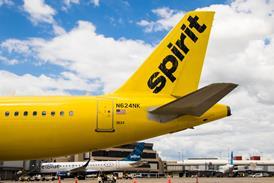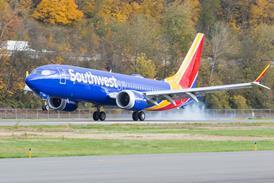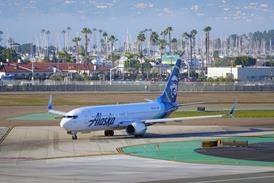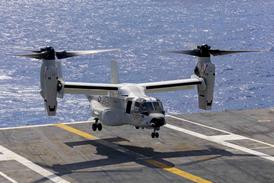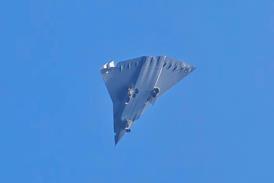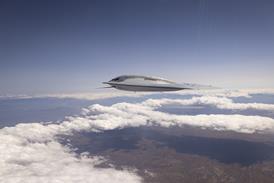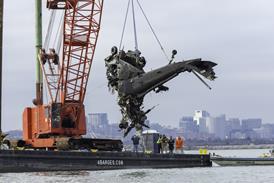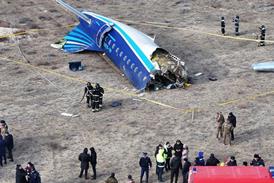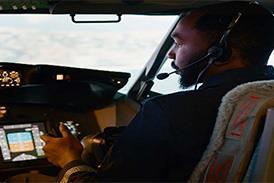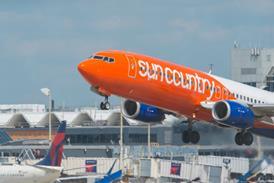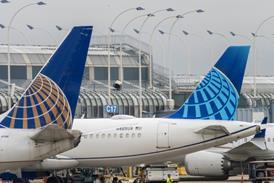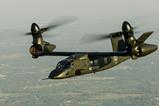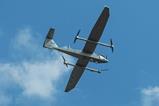Northrop Grumman and the US Air Force (USAF) plan to increase production rates on the USA’s next-generation stealth bomber, at a cost to the company’s short-term profits.
During a 22 April call with investors, Northrop chief executive Kathy Warden said the aerospace and defence manufacturer absorbed $477 million in losses on the secretive B-21 Raider programme during the first quarter of this year. The financial hit was largely the result of changes to Northrop’s B-21 manufacturing process aimed at increasing production rates on the stealth bomber.
“That process change supports the accelerated production rates,” Warden says, noting the adjustment and associated financial loss were a one-time event. “This positions us to ramp to the quantities needed in full rate production.”
Increased costs related to unnamed materials used in the aircraft assembly process also contributed to the $477 million in losses during the three-month period.

Northrop is currently in the low-rate initial production (LRIP) stage of the B-21 bomber programme, with the first two aircraft lots under contract and options for an additional three. At least one B-21 is in flight testing, with six more examples known to be under construction.
Warden has previously said Northrop faces the risk of losing money on the initial crop of B-21 aircraft. The company has already posted some $2 billion in losses spread across the five B-21 LRIP lots.
That is not necessarily cause for concern in the long-run. The initial engineering and test phases of military development contracts typically carry lower margins and greater technical risk, which can be recouped during the full-rate production and sustainment portions of the programme.
Along those lines, Warden says Northrop still expects to turn a profit on B-21s produced after low-rate initial production, even though the air force contract imposes strict price controls.
“We continue to expect [those] aircraft to be profitable,” she notes. “We actually expect these changes will positively impact our ability to deliver [those] units profitably.”
The B-21 is to eventually replace the small fleet of Northrop B-2 Spirit stealth bombers and Boeing B-1B heavy conventional bombers. The air force has publicly committed to fielding at least 100 B-21s, with the first aircraft scheduled to enter operational service before the end of this decade.
However, the costly manufacturing change undertaken by Northrop indicates the USAF may be looking to both speed up the B-21’s fielding and, possibly, the overall fleet target.
“We can ramp beyond the quantities in the programme of record,” says Warden. “Which is something that we and the government decided was important for the optionality to support the scenarios that they have been looking at to increase the current build rate.”
No production rate for the B-21 has been publicly disclosed by either Northrop or the Pentagon, with both citing the classified nature of the programme. However, the figure was believed to be in the single-digits per year, under the previous manufacturing schedule.
Senior US officials say the long-range penetrating strike capability of the B-21 represents an essential ability against modern adversaries, particularly in the expansive Indo-Pacific theatre.
A 2020 report by the Mitchell Institute for Aerospace Studies found that China’s anti-access/area-denial strategy, characterised by long-range surface-to-air missiles and increasingly advanced fighters, would force non-stealth bombers like the Boeing B-52 and B-1B to remain at least 400nm (741km) from China’s coast.
The USAF’s current bomber mix is dominated by such aircraft, with only 18 operational B-2s compared to a combined 112 B-52s and B-1Bs. This would force Washington into an over-reliance on expensive and numerically limited long-range weapons like the Lockheed Martin AGM-158 Joint Air-to-Surface Standoff Missile for strike missions.
Current estimates project that the Pentagon could expend its supply of such munitions in the opening weeks of a high-intensity conflict, with annual production capacity sitting below 1,000 units annually.
The penetrating capability of the B-21 unlocks the possibility of using cheaper and more-plentiful gravity bombs, equipped with Boeing’s Joint Direct Attack Munition guidance kit, to strike key targets inside enemy territory.
Just how many B-21s ultimately will make it to active service remains to be seen.
Although steps are being taken to potentially increase the fleet beyond 100 examples, the bomber programme faces a chaotic budget environment in Washington and pressure from competing priorities.
Even with a contractually mandated price ceiling of $500 million per aircraft in 2010 valuations ($719 million in 2024 dollars), each B-21 will still be extraordinarily expensive.
The USAF currently pays around $80 million for a single Lockheed F-35A stealth fighter, a programme renowned for its high price tag.
In the past, cost pressures have forced the air force to significantly cut its acquisition of new combat aircraft well below initial targets, including for the trailblazing B-2 stealth bomber and the Lockheed F-22 air superiority fighter. The B-2’s final price of $1.1 billion per aircraft in 1998 dollars significantly informed the cost controls included on the B-21 programme.
Thirty-two years after the first frontline B-2 was delivered, the Raider successor faces budgetary competition from other air force modernisation initiatives, including the Sentinel inter-continental ballistic missile programme and the newly announced Boeing F-47 sixth-generation fighter.
That aircraft, developed under the Next Generation Air Dominance programme, is expected to cost upwards of $200 million per unit.


